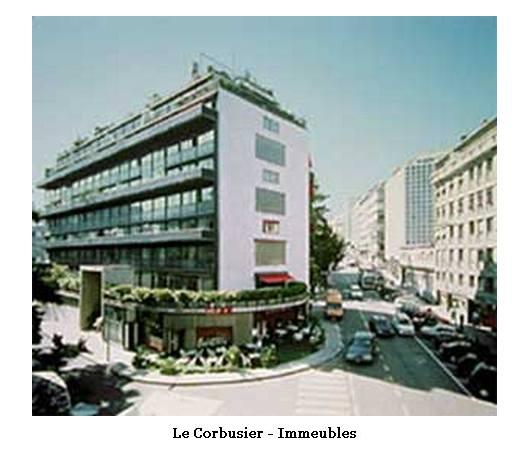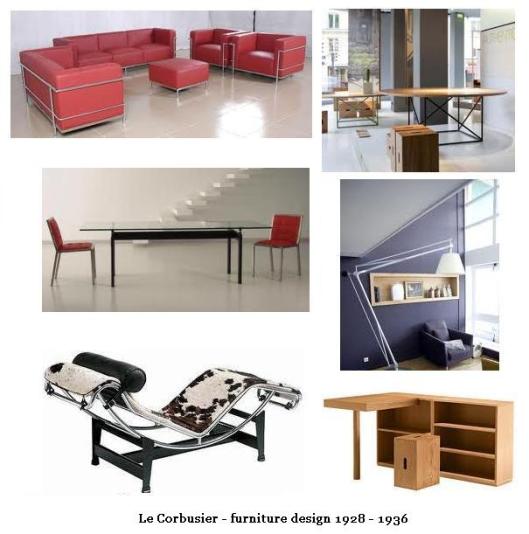Le Corbusier / 2
| 22/10/2012 | Autor SysAdmin Categorii: Arta |
 Pentru un timp oficialii francezi au încercat sa se preocupe de mizeria din mahalale Parisului. Le Corbusier a căutat modalităti eficiente de a crea facilitati de spatiu locativ pentru un număr mare de oameni ca răspuns la criza locuintelor urbane. El credea că formele arhitecturale noi si moderne ar putea oferi o solutie nouă de organizare, care poate contribui la ridicarea calitatii vietii pentru clasele de jos ale societatii. Constructiile sale Immeubles (1922) au reprezentat un astfel de proiect care a solicitat blocuri mari, formate din apartamente individuale, puse unul peste altul, cu planuri care includeau un living, dormitor si bucătărie, precum si o terasă cu grădină.
Pentru un timp oficialii francezi au încercat sa se preocupe de mizeria din mahalale Parisului. Le Corbusier a căutat modalităti eficiente de a crea facilitati de spatiu locativ pentru un număr mare de oameni ca răspuns la criza locuintelor urbane. El credea că formele arhitecturale noi si moderne ar putea oferi o solutie nouă de organizare, care poate contribui la ridicarea calitatii vietii pentru clasele de jos ale societatii. Constructiile sale Immeubles (1922) au reprezentat un astfel de proiect care a solicitat blocuri mari, formate din apartamente individuale, puse unul peste altul, cu planuri care includeau un living, dormitor si bucătărie, precum si o terasă cu grădină.


Eng. For a number of years French officials had been unsuccessful in dealing with the squalor of the growing Parisian slums, and Le Corbusier sought efficient ways to house large numbers of people in response to the urban housing crisis. He believed that his new, modern architectural forms would provide a new organizational solution that would raise the quality of life for the lower classes. His Immeubles Villas (1922) was such a project that called for large blocks of cell-like individual apartments stacked one on top of the other, with plans that included a living room, bedrooms and kitchen, as well as a garden terrace.

Corbusier spunea: “scaunele sunt arhitectura, canapelele sunt burgheze”. Le Corbusier a început să experimenteze un design de mobilier în 1928 după ce a invitat-o pe arhitecta Charlotte Perriand să se alăture studioului sau. Vărul său, Pierre Jeanneret, de asemenea a colaborat la multe dintre modelele produse. Înainte de sosirea lui Perriand, Le Corbusier s-a bazat pe mobila prefabricata ca baza la proiectele sale, cum ar fi piese simple fabricate de Thonet, compania care producea modelele sale în anii 1930.

Eng.Corbusier said: “Chairs are architecture, sofas are bourgeois”. Le Corbusier began experimenting with furniture design in 1928 after inviting the architect, Charlotte Perriand, to join his studio. His cousin, Pierre Jeanneret, also collaborated on many of the designs. Before the arrival of Perriand, Le Corbusier relied on ready-made furniture to furnish his projects, such as the simple pieces manufactured by Thonet, the company that manufactured his designs in the 1930s.

În 1928, Le Corbusier şi Perriand au început să pună in practica proiectele lor pentru mobilier Le Corbusier, proiecte care le vor prezenta în cartea lui din anul 1925 L’Art d’aujourd’hui Décoratif. În carte, el a definit trei tipuri diferite de mobilier: tipul de utilitate, tipul de obiect şi tipul decorativ.
Eng.In 1928, Le Corbusier and Perriand began to put the expectations for furniture Le Corbusier outlined in his 1925 book L’Art Décoratif d’aujourd’hui into practice. In the book he defined three different furniture types: type-needs, type-furniture, and human-limb objects.

El a definit mobilierul ca extensie a membrelor umane, sustinand ca: ” Mobilierul trebuie sa fie extensii ale membrelor noastre şi adaptat la funcţiile umane, care sunt de tip nevoie şi de tip funcţii, prin urmare mobilierul trebuie sa fie produs la nivelul membrelor corpului uman devenind un servitor docil. Un servitor bun este discret si modest, în scopul de a-si lăsa stăpânul său liber. Desigur, operele de artă sunt obiecte frumoase de bun gust, manifestat prin alegere, subtilitate, proporţie şi armonie “.

Eng. He defined human-limb objects as: “Extensions of our limbs and adapted to human functions that are type-needs and type-functions, therefore type-objects and type-furniture. The human-limb object is a docile servant. A good servant is discreet and self-effacing in order to leave his master free. Certainly, works of art are tools, beautiful tools. And long live the good taste manifested by choice, subtlety, proportion, and harmony”.
Bibliografie, note si citate:
Brooks, H. Allen. Le Corbusier’s Formative Years: Charles-Edouard Jeanneret at La Chaux-de-Fonds, Paperback Edition, University of Chicago Press, 1999.
Curtis, William J.R. Le Corbusier: Ideas and Forms, Phaidon, 1994.
Jencks, Charles. Le Corbusier and the Continual Revolution in Architecture, The Monacelli Press, 200.
Wikicommons (Eng. & Fr.)
Instructiuni comentarii:
Pentru a comenta sub identitatea de pe blogul anterior TheophylePoliteia autentificati-va mai intai, apasand pe iconul corespunzator din formular. [ Ex. pentru autentificare Wordpress apasati iconul

